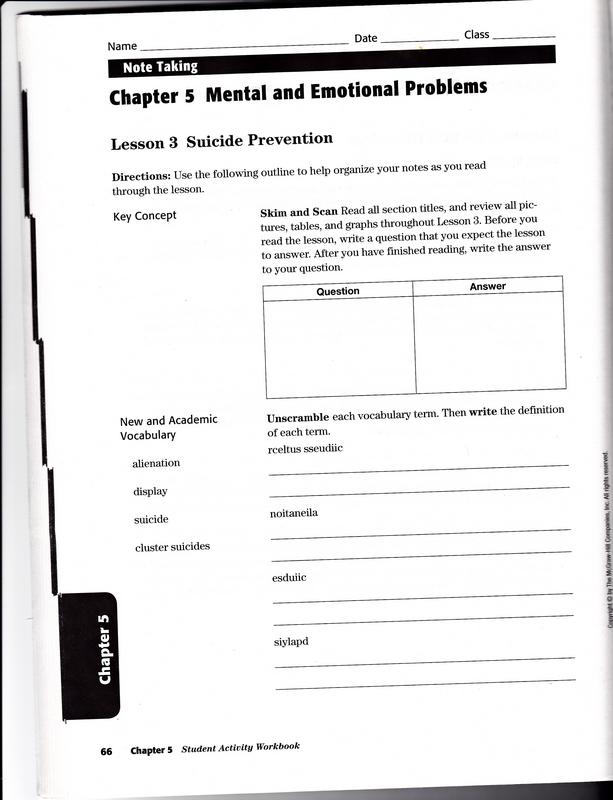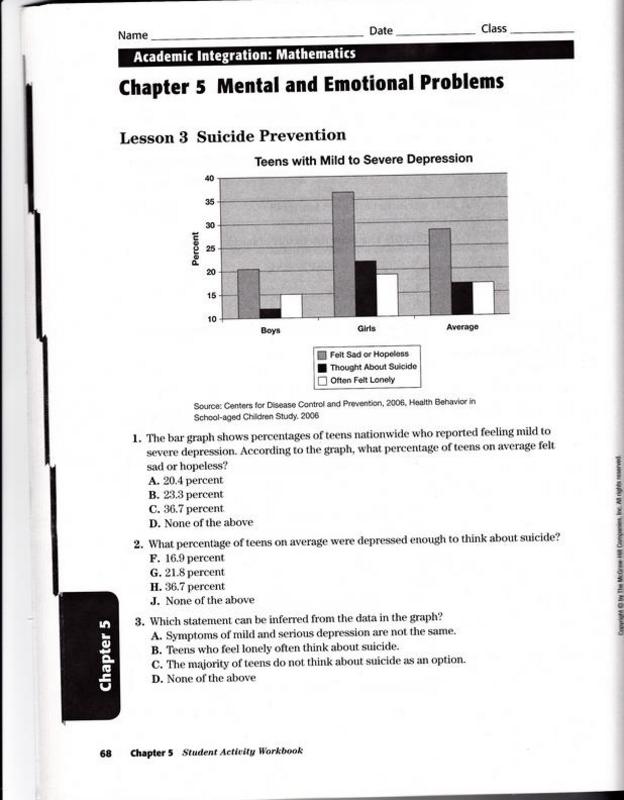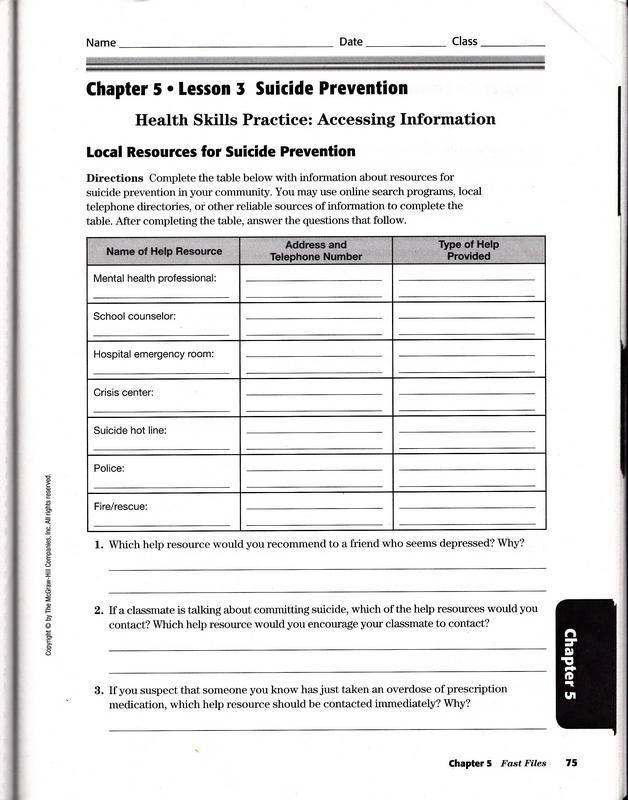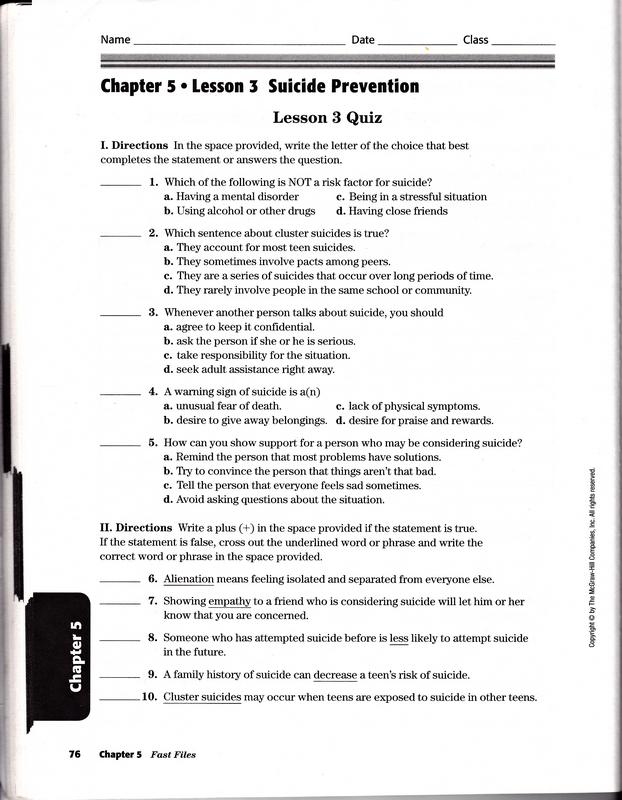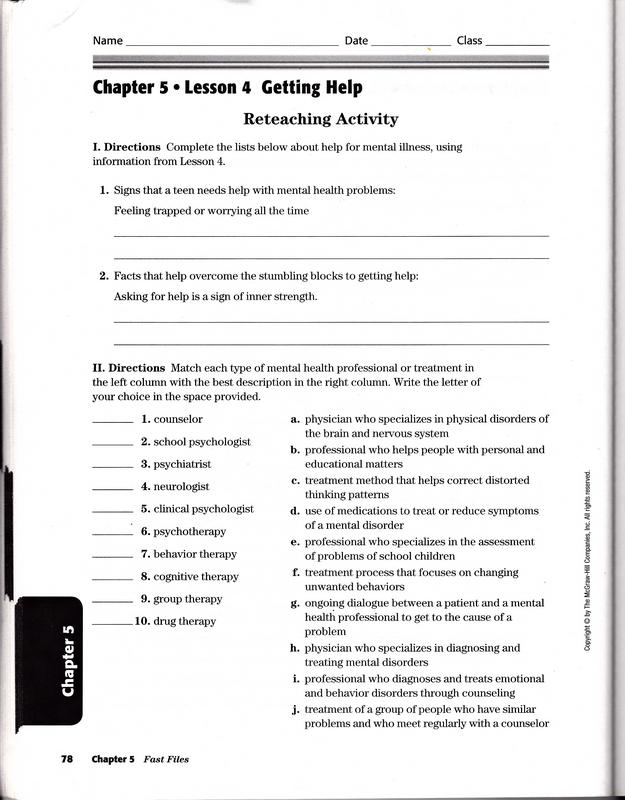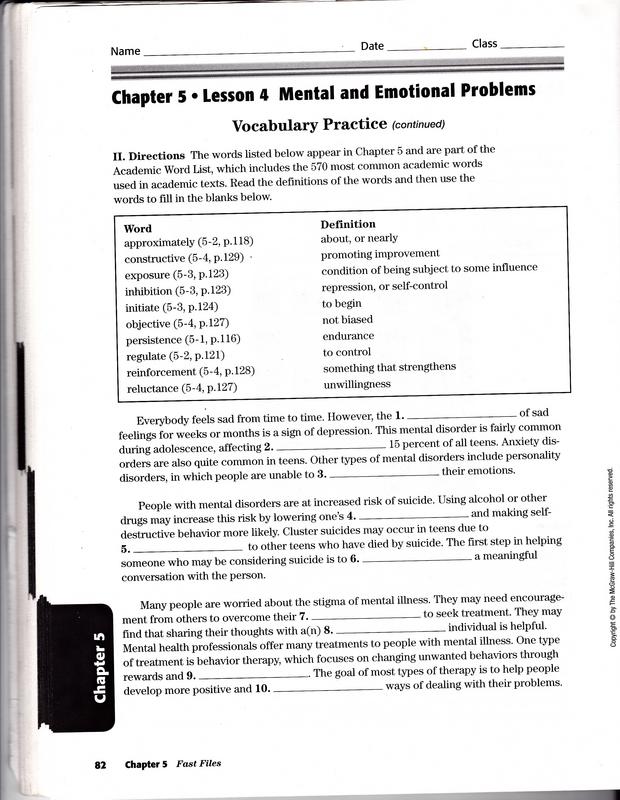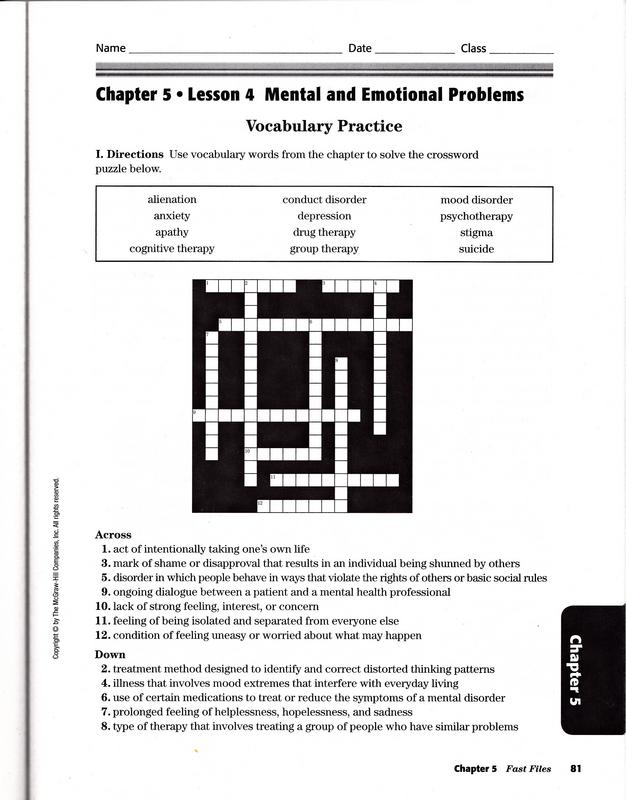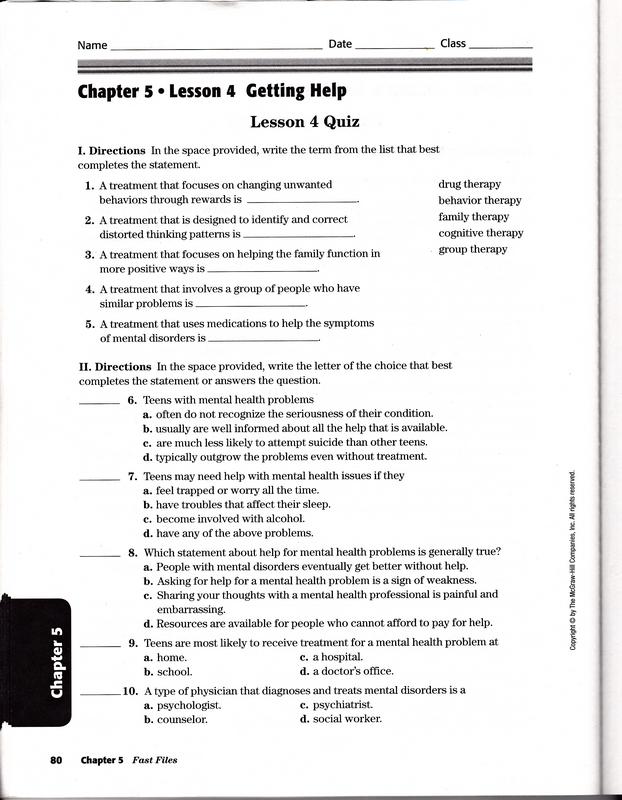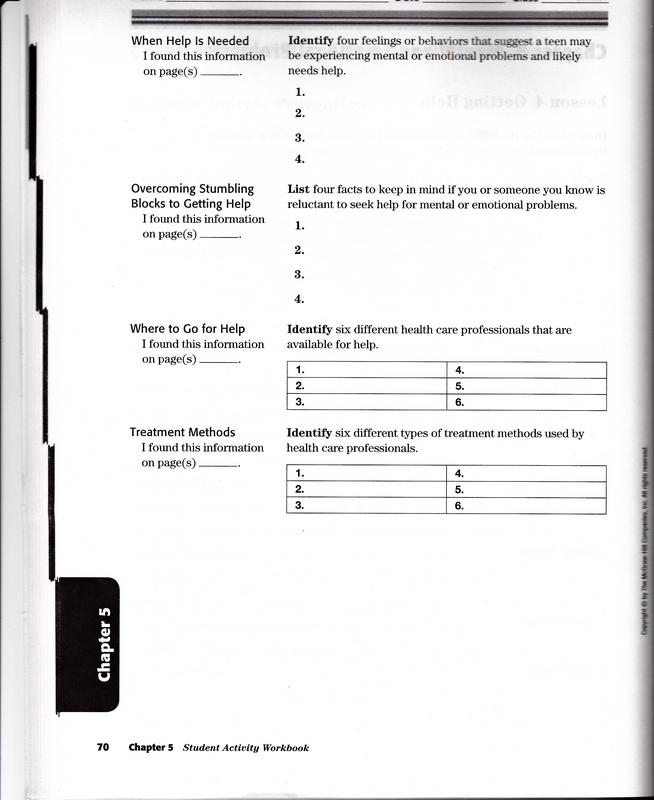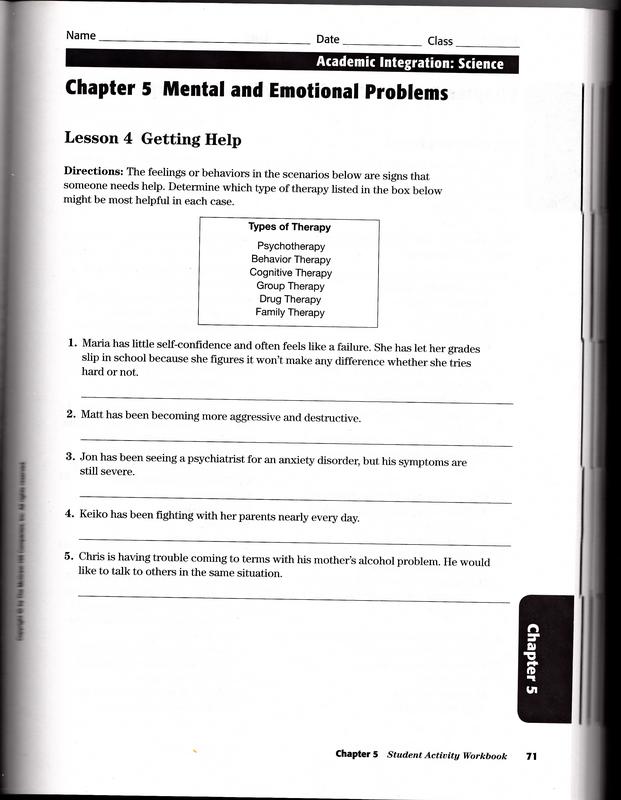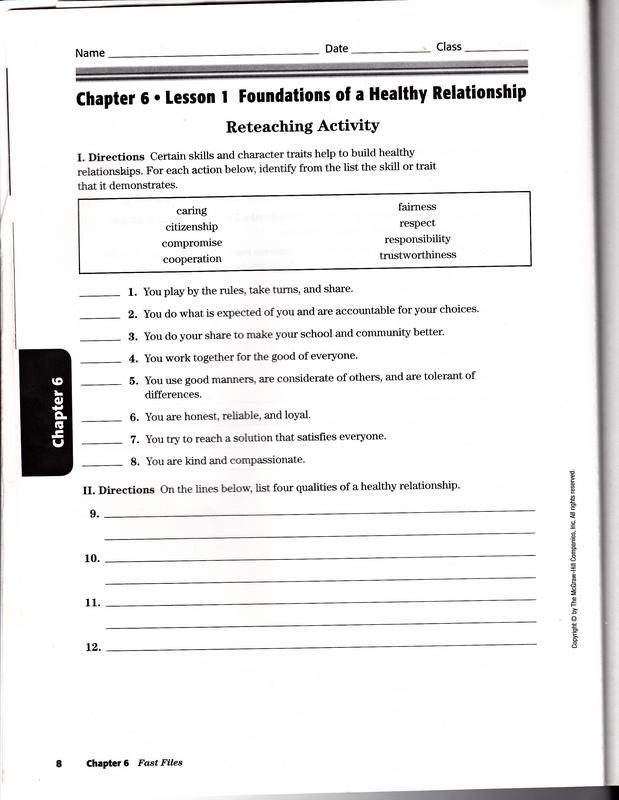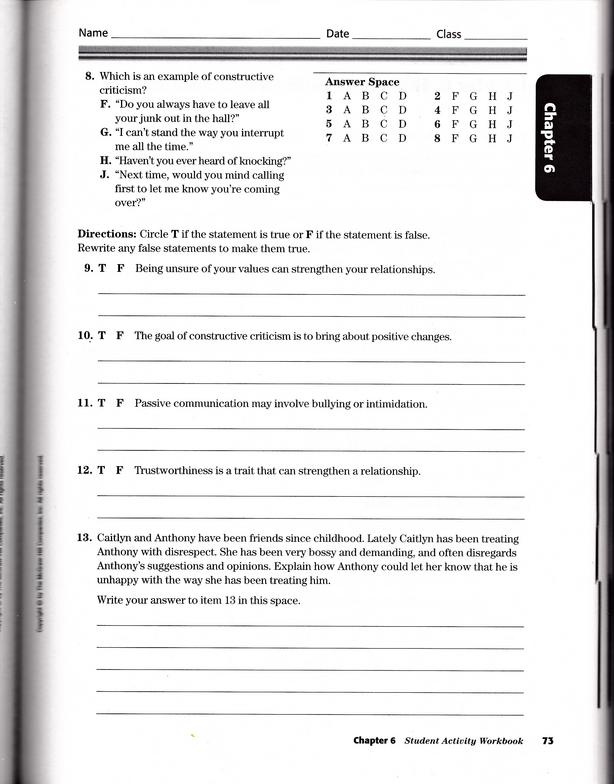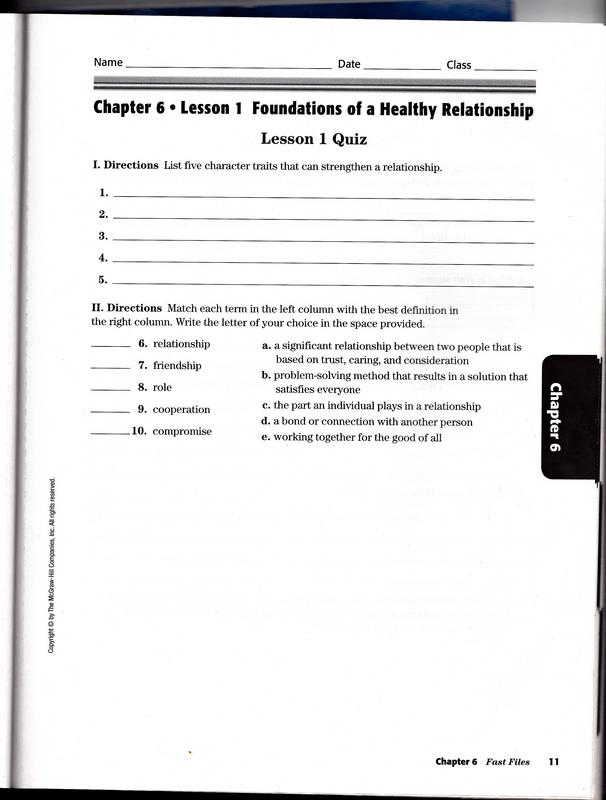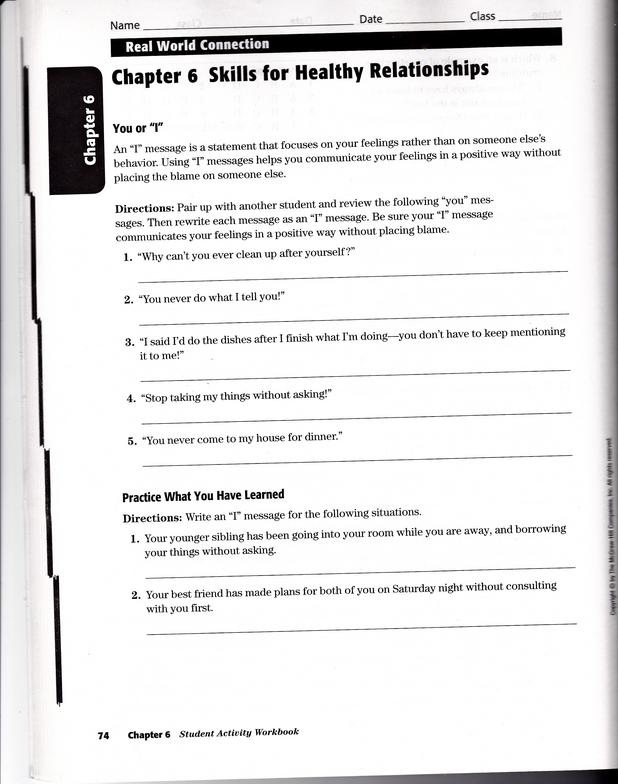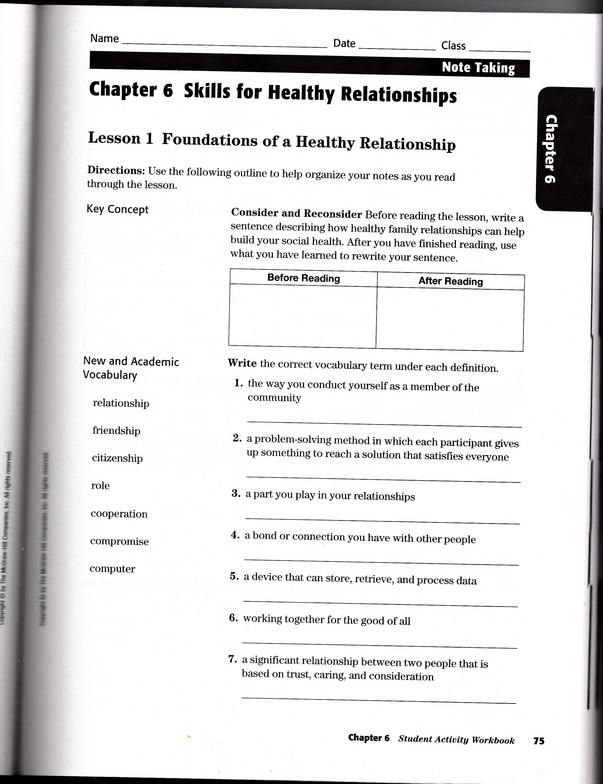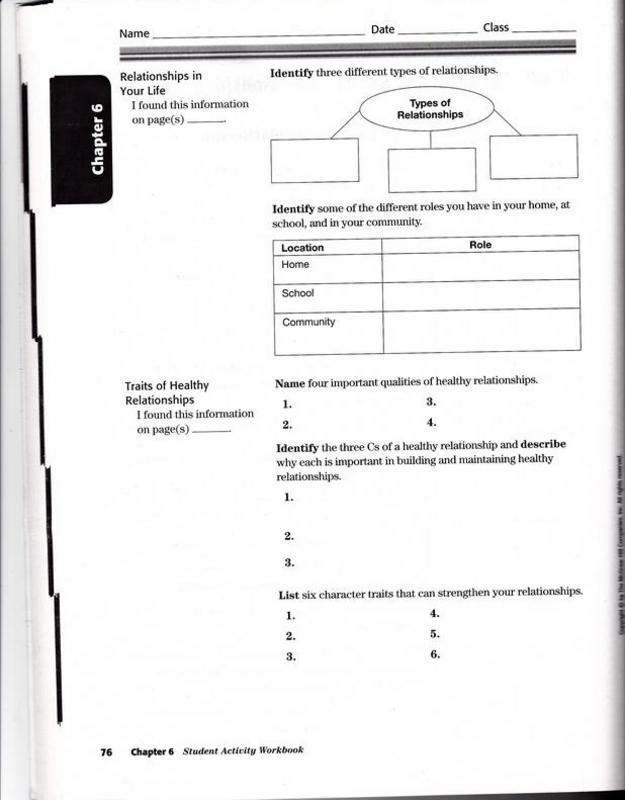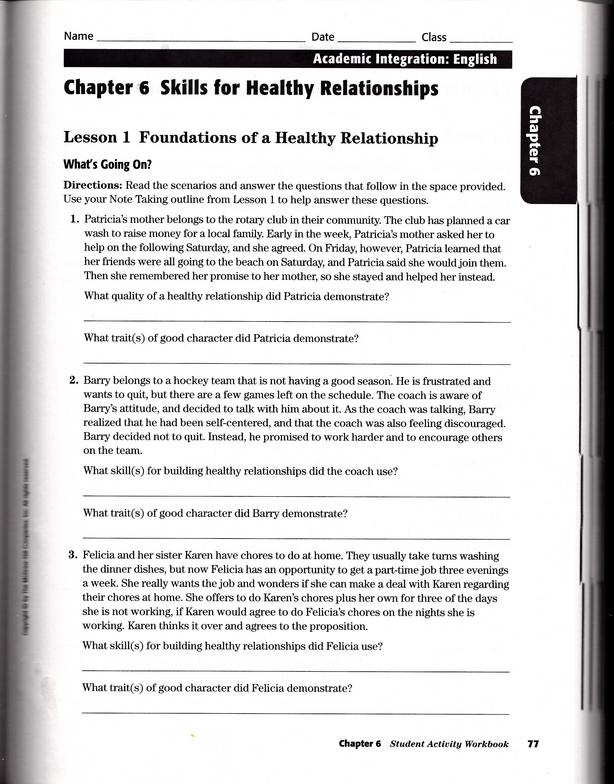PHS HEALTH & PHYSICAL EDUCATION WEBSITE
NOVEMBER 3-ASSIGNMENT
testmoz.com/381502 password: ph2
NOVEMBER 19-ASSIGNMENT
Read Chapter 5-Lesson 3
Identify some reasons why alcohol and drugs make self-destructive behavior more likely.
List 2 risk factors that are characteristic of more than 90 percent of people who commit suicide:
Identify 4 other risk factors of suicide:
NOVEMBER 20-ASSIGNMENT
NOVEMBER 21-ASSIGNMENT
NOVEMBER 22-ASSIGNMENT
DECEMBER 2-ASSIGNMENT
Read Chapter 5-Lesson 4
DECEMBER 3-ASSIGNMENT
DECEMBER 4-ASSIGNMENT
DECEMBER 5-ASSIGNMENT
DECEMBER 6-ASSIGNMENT
DECEMBER 9-ASSIGNMENT
DECEMBER 10-ASSIGNMENT
DECEMBER 11-ASSIGNMENT
There are several different health professionals that can treat mental disorders. Name the health professional that is BEST described by the following statements:
A. I can prescribe medications to treat mental disorders
B. Some of us can prescribe medications, but I mostly concentrate on treating emotional and behavioral disorders with counseling.
C. I am a professional who specializes in the learning, emotional, and behavioral issues of school children
D. I am a professional who handles personal and educational matters
E. I am a physician who specializes in the physical disorders of the brain and nervous system
F. I am a professional who provides guidance and treatment for emotional problems in a hospital, mental health clinic, or a family service agency
DECEMBER 12-ASSIGNMENT
Chapter 5 Test Review
MULTIPLE CHOICE
Select the best answer for each question or statement below
1 Occasional mild anxiety is usually caused by:
Occasional mild anxiety is usually caused by:
2 Apathy is most commonly a symptom of
Apathy is most commonly a symptom of
3 Treatment for depression may include
Treatment for depression may include
4 An example of an impulse control disorder is
An example of an impulse control disorder is
5 Delusions, hallucination, and thought disorders are associated with
Delusions, hallucination, and thought disorders are associated with
6 Exposure to other teens who have died by suicide is a risk factor for
Exposure to other teens who have died by suicide is a risk factor for
7 An important step in helping someone who is suicidal is to
An important step in helping someone who is suicidal is to
8 Mental disorders often go untreated because
Mental disorders often go untreated because
a) many people fail to seek treatment because of the stigma attached to mental illness
9 According to the book, suicide is the____ leading cause of death among teens
According to the book, suicide is the____ leading cause of death among teens
a) 2nd
10 Most teens get help for mental health issues at:
Most teens get help for mental health issues at:
11 If you cannot get over a loss in your life, you may need help with a(n)_________ disorder
If you cannot get over a loss in your life, you may need help with a(n)_________ disorder
12 Gambling compulsively may be a sign of a(n) _________ disorder
Gambling compulsively may be a sign of a(n) _________ disorder
a) adjustment
13 A physician that specializes in physical disorders of the brain and nervous system is a(n)
A physician that specializes in physical disorders of the brain and nervous system is a(n)
14 An example of ____________ therapy is rewarding a patient for efforts to change her/his behavior
An example of ____________ therapy is rewarding a patient for efforts to change her/his behavior
15 What type of treatment can be provided by a psychiatrist but not by most psychologists
What type of treatment can be provided by a psychiatrist but not by most psychologists
16 What is the first step you should take if you think a friend is considering suicide
What is the first step you should take if you think a friend is considering suicide
WORD BANK
17 anxiety
anxiety
18 apathy
apathy
19 personality disorder
personality disorder
20 stigma
stigma
21 schizophrenia
schizophrenia
22 alienation
alienation
23 psychotherapy
psychotherapy
24 drug therapy
drug therapy
25 suicide
suicide
A. mark of shame
B. disorder in which a person is unable to regulate his or her emotions
C. feeling of being isolated or alone
D. feeling uneasy about what may happen
E. use of certain mediations to treat mental disorders
F. prolonged feeling of helplessness, hopelessness, and sadness
G. The act of taking one's own life
H. Ongoing dialogue between patients and a mental health professional
I. Severe mental disorder in which a person loses contact with reality
J. Lack of interest, concern, or feeling about something
MENTAL DISORDERS
Select the disorder below that BEST matches the situations:
26 Stealing, cruelty, lying, violence, aggression
Stealing, cruelty, lying, violence, aggression
27 Panic disorder
Panic disorder
28 Kleptomania
Kleptomania
29 Teens with this disorder cannot regulate their emotions and often feel stressed in social situations
Teens with this disorder cannot regulate their emotions and often feel stressed in social situations
30 Someone who is bipolar is suffering with this kind of disorder
Someone who is bipolar is suffering with this kind of disorder
31 Anorexia is an example of this type of disorder
Anorexia is an example of this type of disorder
A. Conduct Disorder
B. Personality Disorder
C. Mood Disorder
D. Eating Disorder
E. Impulse Control Disorder
F. Anxiety Disorder
NAME THE HEALTH PROFESSIONAL
32 I can prescribe medications to treat mental disorders
33 Some of us can prescribe medications, but I mostly concentrate of treating emotional and behavioral disorders with counseling.
34 . I am a professional who specializes in the learning, emotional, and behavioral issues of school children
35 I am a professional who handles personal and educational matters
36 I am a physician who specializes in the physical disorders of the brain and nervous system
37 I am a professional who provides guidance and treatment for emotional problems in a hospital, mental health clinic, or a family service agency
38-40 List the 3 types of Depression
41 What % of teens will display some type of depression
What % of teens will display some type of depression
42 What is the difference between anxiety and depression?
What is the difference between anxiety and depression?
43 How long can mild depression last?
How long can mild depression last?
a. Months
e. All of the above
TYPES OF THERAPY FOR MENTAL ILLNESSES:
Match the statements below with the type of therapy described by the following scenarios:
44 Someone who has just gotten divorced and is feeling very sad should get_________ therapy
Someone who has just gotten divorced and is feeling very sad should get_________ therapy
45 Someone who fights constantly with their parents should seek_______ therapy
Someone who fights constantly with their parents should seek_______ therapy
46 Someone who is seeing a psychiatrist regularly is probably going through ___________ therapy
Someone who is seeing a psychiatrist regularly is probably going through ___________ therapy
47 Someone who needs medications to treat their mental illness is probably going through _______ therapy
Someone who needs medications to treat their mental illness is probably going through _______ therapy
A. PSYCHOTHERAPY B. DRUG THERAPY C. GROUP THERAPY D. FAMILY THERAPY
48 What is the first step to getting help for a mental health problem?
What is the first step to getting help for a mental health problem? A. Awareness
A. Awareness
49 One in __________ teens commit suicide in the U.S.
One in __________ teens commit suicide in the U.S.
A. 3
50 What is characterized by stealing, cruelty, lying and vandalism?
What is characterized by stealing, cruelty, lying and vandalism?
DECEMBER 13-ASSIGNMENT
Review for Chapter 5 Test
DECEMBER 16-ASSIGNMENT
DECEMBER 17-ASSIGNMENT
DECEMBER 18-ASSIGNMENT
DECEMBER 19-ASSIGNMENT
DECEMBER 20-ASSIGNMENT
JANUARY 7-ASSIGNMENT
6-WEEKS PROJECT ASSIGNED:
DUE: DECEMBER 16
Directions:
Part 1: Construct a 10-question survey to measure awareness and knowledge of any mental health issue or teen suicide.
Part 2: Survey 50 teens and record their answers to your survey.
Part 3: Calculate and graph the results of your survey.
Part 4: Write a one-page paper explaining the results of your research.
Part 5: Present the results and summarize your findings to the class. Explain how you think more teens could become aware of mental health issues and/or suicide prevention, and where and how to get help.
Bonus: Audio-visual aids, handouts, additional research, ect....
HAPPY THANKSGIVING TO ALL OF YOU!!
Today's PURPOSE STATEMENT: This lesson/assignment will prepare students to assist others in need of mental health therapy by discussing the five types of therapy available to people who have mental health problems; detailing five different mental health professionals and how they administer treatment to their mental health patients, and various signals to look out for that individuals with mental health issues may show
Today's PURPOSE STATEMENT: This lesson/assignment will review 10 pertinent vocabulary words from pages 116-128 in Chapter 5 and prepare students to assist others with mental health problems.
Today's PURPOSE STATEMENT: This lesson/assignment will review 12 important terms in Chapter 5 so that students can be abreast of how to help individuals that need mental health therapy.
Today's PURPOSE STATEMENT: This lesson/assignment will review five types of mental health therapy. This lesson will also reveal key facts pertaining to real-world mental health issues so that students can be prepared to assist a peer or someone they know that is having mental health problems.
THE BIG QUESTION:
Nearly everyone is mildly depressed at some time in their life. A study was conducted on more than 9,000 people ages 18 and older. 57% of those who had major depression sought help from a professional. That rate is almost 40% higher that the rate reported 20 years earlier. Why?
THE BIG QUESTION:
Why do you think cluster suicides impact teenagers more than any other age group?
THE BIG QUESTION:
How might two different mental health professionals treat the same person with the same symptoms differently? Hypothetically create a patient, name her/him, define the symptoms and the treatments the two mental health professionals might administer. Discuss AND explain the why the differences might exist. Can you come up with a more effective way of treating the same individual?
THE BIG QUESTION:
Explain some of the challenges you might face in getting the needed help if you had a close friend that showed signs that they needed mental health therapy.
CATCH UP DAY- use this time to catch up on all of your missing assignments. The PROGRESS REPORTS I gave you yesterday, should list all of your missing assignments.
Also, many of you have not completed the ROLE MODEL PROJECT. This assignment was worth a TEST GRADE. Since it was due on
DEC 2...you will get 30 points off by turning it in today....3 days late.
25a. depression
Double click here to add text.
This WEEK'S PURPOSE STATEMENT: This lesson/assignments this week will review the types treatments availkable to mental health patients, behaviors that signal that someone might have mental health issues, and the types of mental health professionals available to patients. This lesson will also reveal key facts pertaining to real-world mental health issues so that students can be prepared to assist a peer or someone they know that is having mental health problems.
This WEEK'S PURPOSE STATEMENT: The lessons/assignments this week will discuss the traits of healthy relationships in such a way to make students keenly aware of good versus bad relationships. These lessons will also give the students strategies to navigate the "mine-field" of POSITIVE human to human relationships whether they be friend, foe, a love interest, work colleagues, or acquaintances.
THE BIG QUESTION:
Explain some of the challenges in using "I" mesages to diffuse a potentially violent confrontation then.... Compare how you would use it to break up a conflict involving others opposed to how you would use "I" messages to counter aggressive behavior toward YOU.
TEST ON CHAPTER 5 TODAY!!
NOVEMBER 4-ASSIGNMENT
testmoz.com/381518 password: ph2
NOVEMBER 5
Your quiz is available at: testmoz.com/381602
Make sure you tell your students the quiz passcode: ph2
NOVEMBER 6
Your quiz is available at: testmoz.com/382393
Make sure you tell your students the quiz passcode: ph2
NOVEMBER 7
Your quiz is available at: testmoz.com/382515
Make sure you tell your students the quiz passcode: ph2
NOVEMBER 10 --SELF ESTEEM quiz
Your URL is: testmoz.com/386151
Password: ph2
NOVEMBER 11--DEFENSE MECHANISMS
Your URL is: testmoz.com/386274
Password: ph2
The test has been published!
Make sure you tell your students the quiz passcode: ph2
NOVEMBER 12- CH 3 PGS 76-77
Your URL is: testmoz.com/386283
Passcode: ph2
The test has been published!
Your quiz is available at: testmoz.com/386283
Make sure you tell your students the quiz passcode: ph2
NOVEMBER 13-CH 3 PGS. 78-79
Your URL is: testmoz.com/386294
Passcode: ph2
The test has been published!
Your quiz is available at: testmoz.com/386294
Make sure you tell your students the quiz passcode: ph2
NOVEMBER 14-CH 3 PGS. 80-81
Your URL is: testmoz.com/386304
Passcode: ph2
The test has been published!
Your quiz is available at: testmoz.com/386304
Make sure you tell your students the quiz passcode: ph2
NOVEMBER 17
The test has been published!
Your quiz is available at: testmoz.com/386628
Make sure you tell your students the quiz passcode: ph2
NOVEMBER 18
The test has been published!
Your quiz is available at: testmoz.com/386634
Make sure you tell your students the quiz passcode: ph2
NOVEMBER 19
The test has been published!
Your quiz is available at: testmoz.com/386660
the quiz passcode: ph2
Your URL is: testmoz.com/386660
Password: ph2
NOVEMBER 20
The test has been published!
Your quiz is available at: testmoz.com/386670
Make sure you tell your students the quiz passcode: ph2
The Learner Will (TLW): Understand some of the important concepts of good mental and emotional health.
The Learner Will (TLW): Become familiar with some of the important aspects of emotional health.
The Learner Will (TLW):Be introduced to Abraham Maslow's Hierarchy of Human Needs triangle, and understand how each level must be reached before a person can come up to the next level.
The Learner Will (TLW): Examine various aspects of emotional health and understand how and why they are important to overall health.
The Learner Will (TLW): Understand what SELF-ESTEEM is, how it is formed, how one can manage their own self-esteem, and why good self-esteem is important to overall good health.
The Learner Will (TLW): Understand what DEFENSE MECHANISMS are, how they are used, and why each person develops them.
The Learner Will (TLW): Understand what overall health is impacted by high-risk behaviors, what constructive criticism is and how it can strengthen relationships, and how one's community is an important part of a person's overall health.
The Learner Will (TLW): Understand how expressing emotions in healthful ways can be a benefit to all and help overall health.
The Learner Will (TLW): Understand how expressing emotions in healthful ways can be a benefit to all and help overall health.
The Learner Will (TLW): Understand how managing emotions in healthful ways can be a benefit to all and help overall health.
The Learner Will (TLW): Understand how managing emotions in healthful ways can be a benefit to all and help overall health.
CHAPTER 3 TEST--NOVEMBER 21
The last day to submit your test is FRIDAY, NOVEMBER 24
The test has been published!
Your quiz is available at: testmoz.com/396886
Make sure you tell your students the quiz passcode: ph2
DEC 2
testmoz.com/398814
password: ph2
DEC 3 pgs. 92-94
testmoz.com/404938
password: ph2
DEC 4. Watch the video located here:
http://www.cbsnews.com/news/stress-in-america-survey-reveals-teens-feel-more-pressure-than-adults/
The test has been published!
Your quiz is available at: testmoz.com/404958
Make sure you tell your students the quiz passcode: ph2
DEC 5
The test has been published!
Your quiz is available at: testmoz.com/405319
Make sure you tell your students the quiz passcode: ph2
PURPOSE STATEMENT: The Learner Will (TLW): Understand how STRESS can be harmful to your health.
PURPOSE STATEMENT: The Learner Will (TLW): Understand how teen and adult stress can be harmful to your health.
PURPOSE STATEMENT: The Learner Will (TLW): Understand the stages of stress.
CHAPTER 3 TEST
1. You are displaying _________ if you think before you act and consider the consequences.
2. If you share, are open-minded, and listen to others, you are displaying _______________
3. If you are kind and compassionate, express gratitude, and are forgiving to others, you are displaying________________
4. If you advocate for a safe and healthy environment at school and in your community, you are displaying:___________
5. If you are considerate of others and accept their differences you are showing _________.
6. To improve your self-esteem, choose _______ who value and respect you.
7. ________ things you can't change, and focus your energy on changing the things you can.
8. ___________ negative self-talk with supportive self-talk.
9. Consider your mistakes learning ________________.
10. _______________ your time to help someone.
11. Write down your goals and the _________ you will take to achieve them.
12. ___________ is making up for weaknesses and mistakes through gift giving, hard work, or extreme efforts.
13. Making excuses to explain a situation or behavior, rather than taking responsibility for it is called:__________________
14. The defense mechanism that is defined as: Involuntarily pushing unpleasant feelings out of one's mind is called:_____________
15. The defense mechanism that is defined as: Consciously and intentionally pushing unpleasant feeling out of one's mind is called ____________.
16. Within a meaningful relationship, family, friends, or others may give you _____________ _____________, or non-hostile comments that point out problems and encourage improvement.
17. _______-taking is part of life.
18. __________ __________ is your sense of self as a unique individual.
19. A ______ _______ can influence a person to assume certain desirable characteristics or set a goal to have a similar career
20. Feeling happy, sad, excited, or scared are types of __________
21. Changes during puberty are caused by __________--which are chemicals produced by your glands that regulate the activities of different body cells.
22. __________ swings are a part of teenage life.
23. The emotion described as being: satisfied and feeling positive is called:
24. A strong affection, deep concern, and respect describe this emotion.
25. When you are startled by someone or something, you may feel ______.
26. The feeling of shame and regret that occurs when you act against your values.
27. ________ language is directly related to your emotions.
28. __________ is the ability to imagine and understand how someone else feels.
29. An individual's response to emotion may be __________ or negative.
30. ___________ __________ are mental processes that protect individuals from strong or stressful emotions and situations.
31. Defense mechanisms help an individual to ________ themselves.
32. Which emotion is usually the result of acting in a way that does not agree with your values and beliefs?
33. During the teen years, hormones can impact emotions by:
34. Intentionally avoiding thoughts of an unpleasant emotion is an example of which defense mechanism?
35. The parts of total health that include the ability to accept yourself and manage your emotions
36. Qualities the describe how a person thinks, feels, and behaves
37. When someone has the ability to adapt to change or recover from crisis, they are considered:
38. Mental processes that protect individuals from strong or stressful emotions
39. Signals that tell your mind and body how to react
40. Striving to be the best you can be is called: ______-________
41. Your sense of yourself as a unique individual
42. A complex set of characteristics that make you unique.
43. A sign of good citizenship is showing respect for
44. Individuals with healthy self esteem see themselves in a(n) _________ way.
45. A sense of ________ helps you set goals and work to achieve them.
46. The ability to manage the difficulties that are part of life is called
47. TRUE OR FALSE: Accepting your mistakes and thinking of them as learning opportunities is an effective way to improve self-esteem?
48. According to Maslow, which of the following needs must be met first? PHYSICAL, MENTAL, SELF-ACTUALIZATION, SENSE OF BELONGING
49. TRUE OR FALSE: Some aspects of your identity are PERSONALITY AND CHARACTER
50. The need to love and be loved and the need to belong is Level ____ of Maslow's Hierarchy of Needs
If the Testmoz link does not work. Scroll to bottom of THIS page to take the CHAPTER 3 TEST.
DEC 8
The test has been published!
Your quiz is available at: testmoz.com/409297
Make sure you tell your students the quiz passcode: ph2
PURPOSE STATEMENT: The Learner Will (TLW): Understand the stages of stress.
DEC 9
The test has been published!
Your quiz is available at: testmoz.com/409308
Make sure you tell your students the quiz passcode: ph2.
PURPOSE STATEMENT: The Learner Will (TLW): Understand the stages of stress.
DEC 10
The test has been published!
Your quiz is available at: testmoz.com/409315
Make sure you tell your students the quiz passcode: ph2
DEC 11
The test has been published!
Your quiz is available at: testmoz.com/409330
Make sure you tell your students the quiz passcode: ph2
PURPOSE STATEMENT: The Learner Will (TLW): Understand the EFFECTS of stress.
PURPOSE STATEMENT: The Learner Will (TLW): Understand the EFFECTS of stress both long-term and short-term.
DEC 12
The test has been published!
Your quiz is available at: testmoz.com/409347
Make sure you tell your students the quiz passcode: ph2
PURPOSE STATEMENT: The Learner Will (TLW): Understand the EFFECTS of stress both long-term and short-term.
FINAL EXAM:
The test has been published!
Your quiz is available at: testmoz.com/409519
Make sure you tell your students the quiz passcode: ph2


